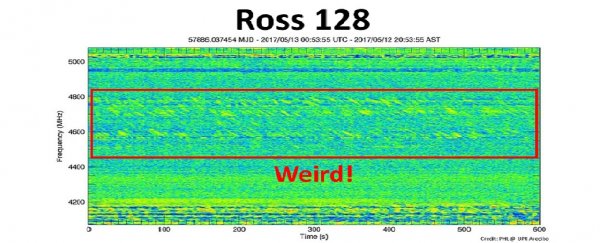In May this year astronomers detected a strange signal that lined up with a star 11 light years away. As usual, if it's a little out of the ordinary we love to make a list of possibilities with 'alien technology' at the bottom, and then hope it's aliens.
Of course it never is, and this tease is no different – it's almost certainly from one of our own satellites. Not that we should be disappointed.
In homage to the famous "Wow!" signal discovered in 1977, this new signal detected several months back with the Arecibo Observatory in Puerto Rico was given the name "Weird!".
Weird is fairly appropriate – in observing a red dwarf star called Ross 128 for about ten minutes, the astronomers detected a signal with a number of unusual properties. It repeated itself in a pattern of sliding down a scale of frequencies; not exactly the whispers you'd expect from a red dwarf.
The list of likely causes was fairly brief; it could be emissions of solar activity from the star, activity from some other far distant unseen body passing in front of the star, or signals produced by known technology high up in Earth's orbit.
Solar flares couldn't be ruled out, but aren't likely given any pattern of signals would be at a much lower frequency.
"Also, there are not many nearby objects in the field of view of Ross 128 and we have never seen satellites emit bursts like that, which were common in our other star observations," astrobiologist Abel Mendez said following the initial discovery.
That doesn't rule anything out, but it is a cause to pause.
As for the signal coming from some non-Earthling form of technology, nothing explicitly ruled it out either. There were just plenty of hypotheses to be dealt with before any ground-breaking reasons could be seriously considered.
No matter how often our hearts get broken, we do have a fascination with the mere possibility that this is how we'll discover intelligence on other worlds – a strange ping we just can't pin down.
Not that you thought this would turn out differently; Weird! isn't that introduction we're looking for, folks.
"After a careful analysis of the observations we performed last Sunday from the Arecibo Observatory, together with SETI Berkeley using the Green Bank Telescope and the SETI Institute's Allen Telescope Array, we are now confident about the source of the Weird! Signal," says Mendez.
"The best explanation is that the signals are transmissions from one or more geostationary satellites."
Like those geostationary satellites, Ross 128's position lines up with the Earth's equator. The objects in high orbit also appear to take longer to cover the relative distance making up the star's area.
There remain one or two other odd discrepancies that still make it a little "weird", such as the odd dispersion of the signal, but Mendez and his team are confident that there are potential explanations for those as well that are grounded in well-established science.
Taking advantage of the media-storm over extra-terrestrial explanations, Mendez conducted an informal poll on what science enthusiasts thought might have caused the Weird! signal in the absence of extra data.
About 800 people responded, including a few dozen astronomers, and most thought stellar activity or some other astronomical source was highly likely. Fewer people expected glitches, errors, or the satellite explanation.
What was interesting was a significant minority of around 200 people were super sure it had to be aliens. This was balanced by a slightly bigger crowd who were equally adamant it wasn't.
It wasn't exactly a peer-reviewed survey following strict methodology, but Mendez's straw-poll does seem to reflect our love-hate relationship with the sci-fi side of astronomy.
Futurism recently conducted its own informal survey asking their readers when they believed alien contact would be made.
Most respondents were confident it would be some time this century, with 27 percent pinning their expectations in the 2020s.
Programs like the Search for Extra-Terrestrial Intelligence (SETI), which use the same facilities as the one that detected the Weird! signal, will have better technology and more data to spot the needle in a haystack ping of any potential alien communications, so we might have good reason to have our hopes raised.
We should also prepare ourselves for hopes to be more frequently dashed.
Only last year researchers found that famous Wow! signal was most likely the signature of a comet and not greetings from another planet.
Space is big, and the chances of undiscovered comets and passing satellites lining up with something interesting is miniscule.
But with more eyes on the sky than ever detecting signals from across the electromagnetic spectrum, even one-in-a-million coincidences will happen with increasing frequency. We should expect plenty more like them in the future.
With astronomers like Mendez being so hesitant to jump to conclusions we can be assured that science is in safe hands, leaving us to daydream "what if…" in the meantime.
